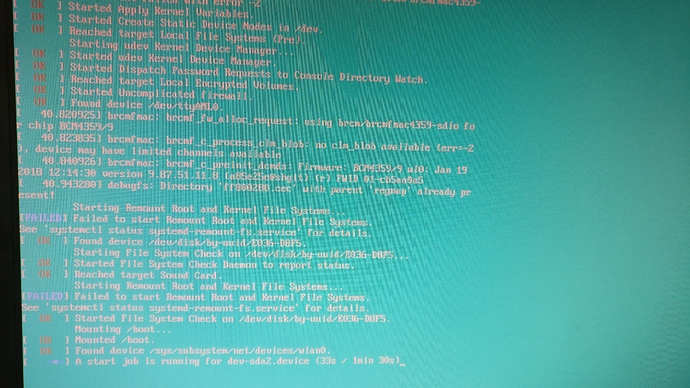@hyphop
Followed your original suggestion and booted off sd card with fstab setting mount points (home,bin etc.) to the external USB ssd nvme.v2 drive. With the fstab settings below, it boots up just fine for the most part, except my resolvconf appears to be broken (can’t access internet, even though I have a valid ip).
I’m also getting a peculiar error during boot:
Current fstab settings I’m using on my sd card using VIM3_Ubuntu-server-bionic_Linux-5.5-rc2_arm64_SD-USB_V0.8.2-20200103:
fstab at https://pastebin.com/b8ZXwvt6 for better readability.
UUID=4b6a2d32-cd63-491b-92a8-b48c721fc07b is sd card rootfs
UUID=E036-D8F5 is sd card boot partition
/dev/sda2 /rootfs ext4 defaults,auto,rw,nofail,x-gvfs-show 0 0
#tmpfs /tmp tmpfs defaults,nosuid 0 1
tmpfs /rootfs/tmp tmpfs defaults,nosuid 0 1
UUID=4b6a2d32-cd63-491b-92a8-b48c721fc07b / ext4 defaults,noatime,nodiratime,commit=600,errors=remount-ro,x-gvfs-show 0 2
UUID=E036-D8F5 /boot vfat defaults 0 3
/dev/sda2 /rootfs ext4 defaults,auto,rw,nofail,x-gvfs-show 0 4
/rootfs/home /home ext4 defaults,auto,bind,rw,nofail,x-gvfs-show 0 5
/rootfs/bin /bin ext4 defaults,auto,bind,rw,nofail,x-gvfs-show 0 6
/rootfs/cdrom /cdrom auto defaults,auto,bind,rw,nofail,x-gvfs-show 0 7
/rootfs/dev /dev ext4 defaults,auto,bind,rw,nofail,x-gvfs-show 0 8
/rootfs/etc /etc ext4 defaults,auto,bind,rw,nofail,x-gvfs-show 0 9
/rootfs/lib /lib ext4 defaults,auto,bind,rw,nofail,x-gvfs-show 0 10
/rootfs/lib64 /lib64 ext4 defaults,auto,bind,rw,nofail,x-gvfs-show 0 11
/rootfs/lost+found /lost+found ext4 defaults,auto,bind,rw,nofail,x-gvfs-show 0 12
/rootfs/media /media auto defaults,auto,bind,rw,nofail,x-gvfs-show 0 13
#/rootfs/mnt /mnt ext4 defaults,auto,bind,rw,nofail,x-gvfs-show 0 14
/rootfs/opt /opt ext4 defaults,auto,bind,rw,nofail,x-gvfs-show 0 15
/rootfs/proc /proc auto defaults,auto,bind,rw,nofail,x-gvfs-show 0 16
/rootfs/root /root ext4 defaults,auto,bind,rw,nofail,x-gvfs-show 0 17
/rootfs/run /run ext4 defaults,auto,bind,rw,nofail,x-gvfs-show 0 18
/rootfs/sbin /sbin ext4 defaults,auto,bind,rw,nofail,x-gvfs-show 0 19
/rootfs/snap /snap ext4 defaults,auto,bind,rw,nofail,x-gvfs-show 0 20
/rootfs/srv /srv auto defaults,auto,bind,rw,nofail,x-gvfs-show 0 21
/rootfs/sys /sys auto defaults,auto,bind,rw,nofail,x-gvfs-show 0 22
/rootfs/usr /usr ext4 defaults,auto,bind,rw,nofail,x-gvfs-show 0 23
/rootfs/var /var auto defaults,auto,bind,rw,nofail,x-gvfs-show 0 24

